Cornhill 2 (Police
Station, Barclays, The Swan, Corn Exchange)
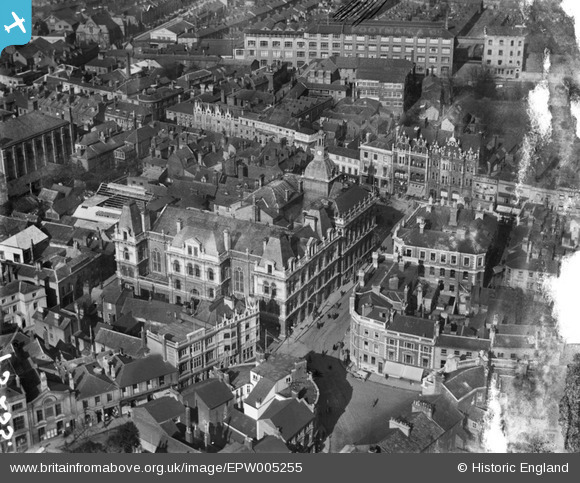 1921 image
1921 image
The above aerial photograph was taken from a light aircraft in 1921,
the angle clearly showing the facade of the Corn Exchange which is
seldom appreciated from the ground. The Public Hall (site of today's
Primark store) can be seen at the top left of the picture; it was built
in 1863 and burnt down in 1948. Following the line of the Public Hall
towards the right is Providence Street with the characteristic facade
of The Crown & Anchor Hotel in
Westgate Street. Across from the top of Providence Street is the mass
of the corset factory with 'FOOTMAN & CO.' lettered on the roof.
this factory occupies the strip of land between Tower Ramparts and
Crown Street (now a car park). To the north is the network of housing
between High Street and Neale Street shown on our Ipswich
Museum page on a 1902 map. Lloyds Avenue
and the Lloyds Arch had yet to be cut through linking Tower Ramparts
with Cornhill. Lloyds banking house faces
the upper part of Princes Street which
runs down to the building we know today as 'Mutual House' on the corner
of King Street. The packed-together
nature of town centre buildings and structures is relieved only by the
Cornhill (not clearly visible here) and the area between Princes
Street, Butter Market and Queen Street which today we know as 'Giles Circus', in the foreground.
Police Station, Town Hall,
Princes Street
The same 'mistaken identity' as the old Post
Office
applies to the side
entrance of the Town Hall and Corn Exchange itself in the upper mouth
of
Princes Street, later used as the Ipswich Borough Entertainments Box
Office and the Age Concern tea room.
Look carefully at the stonework above the door and above the date(1867)
you
can
just make out the words:
'POLICE STATION
MDCCCLXVII'
On the photograph below, the
incised letters having been filled with a compound.
The
Town Hall was built (and rebuilt in 1867, removing all traces of the
original
structure) on the site of one of the most ancient ecclesiastic
buildings
in the town, St Mildred's Chapel, which was probably Anglo-Saxon in
origin.
Ipswich Borough Police were formed in 1836 and occupied the Town Hall
from 1867. The building was used as a police station from that date
until the
current police station
was erected and opened in June, 1968 at the end of Elm Street near to
the site of the long lost
Ipswich
Castle, (which is believed to have been a wooden structure). An officer
of the law in the 19th century wore a beaver skin top hat, blue
swallow-tail coat with white duck trousers for summer and blue for
winter. In
2006 a blue lamp (a la Dixon of Dock
Green) will be added, with a police presence in the
Town Hall to give information. The central police station was later
moved to Museum Street. Another former police station (1930s?),
complete
with filled-in lettering, used to stand in the car park of St Helens
Court, County Hall, St Helens Street
(this part
demolished for apartments to be built).
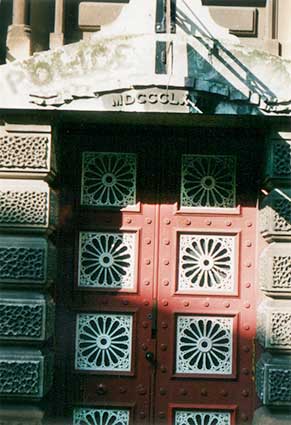
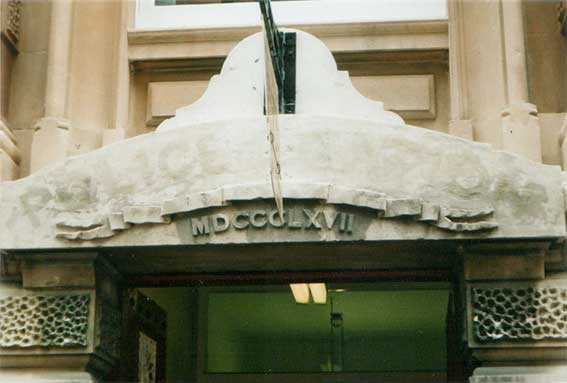 2004 images
2004 images
This Police Station entrance has appeared in a Giles
cartoon – Carl
Giles worked a short distance away and is commemorated by the 'Gran'
sculpture at the junction of Princes Street and Queen Street
nearby
–
of which a detail is shown below. This marked the move to Elm
Street in 1968.
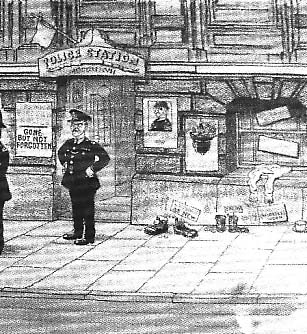
Incidentally, the stretch of the road directly outside
this former police station entrance is notable for the fact that it is
the only place in Ipswich where the original tramlines have been
covered over, rather than ripped up. For a potted history of Ipswich
tramways see our page including Tramway
Place.

Just to confirm this, here is part of the architect's drawing, dated
Decemebr 2005, of the
resfurbishment of the east elevation of the Town Hall (architects:
Bellamy
and Hardy). The caption at lower right reads: 'Proposed position of the
blue
police lamp over the former police entrance'. Note the continuation of
the downhill slope of the pavement from the Cornhill to the right
towards Princes Street/Queen Street clearly
shown ont he drawing.
Barclays Bank, 1 Prince's Street
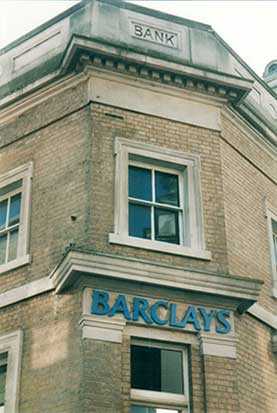 2004 image
2004 image
Opposite and further down the street stands a typical
bank branch with 'BANK' inscribed above the main door on Prince's
Street. It has
a similarly
typical 'BANK' incised in a tablet on the corner with the Thoroughfare;
but why is it so terribly high up?
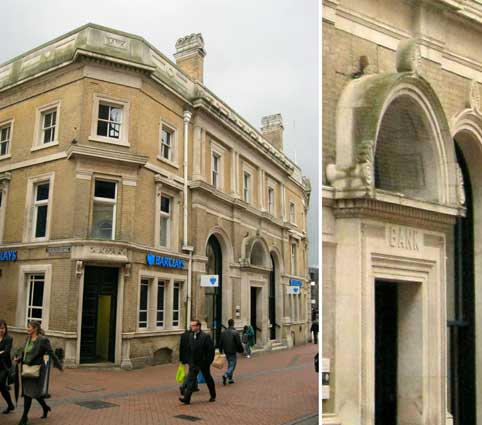 2012
image
2012
image
See our Cornhill 1 page for a dated rain
hopper on Barclays premises further down Thoroughfare.
Another
high 'Bank' sign has been photographed in the central square in Beccles
on the 'out of Ipswich' gallery (an example also on the Felixstowe
page). ('Lloyds arch' on the other side of
the
Cornhill also boasts the relief lettering 'Bank'.)
The Swan Inn, 3-7 King Street
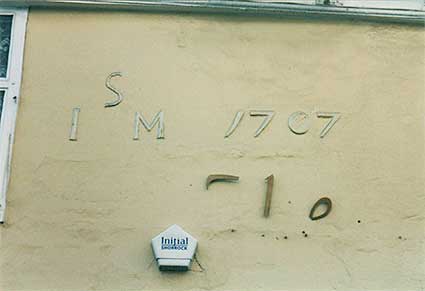 2004 image
2004 image
Round the corner in King
Street stands
an ancient tavern. The Swan Inn
faces
the rear of the Corn Exchange and although the modern lettering which
names
the pub (see the remnants of 'The' below) has been vandalised, the date
lettering and numerals set into the old rendering survive. What does:
'ISM' [or
'SIM'] 1707'
stand for? In 1664 Mr John Parker gave £2 a year, paid
out
of the profits of the Swan Inn, to provide coal for the poor people of
the
parish in which it stands. It was one of the twenty-four inns which
existed in Ipswich by 1689. This shows the Swan to be one of the oldest
public
houses in Ipswich; the date 1707 on the front wall probably signifies
one
of the many alterations to the building which have been made over the
centuries
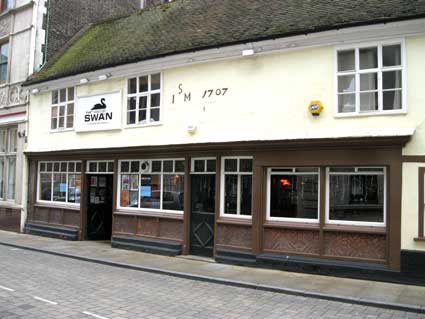 2012 image
2012 image 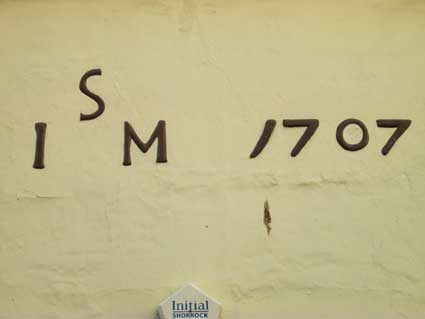 2013
image
2013
image
Grade II Listed: "A C17 timber-framed and plastered
building with C18 and later alterations. The 1st storey bears the
monogram S above I M and the date 1767[sic],
probably the date it was plastered. 2 storeys. 4 window range, C18
casements, 3-lights with transomes. The window at the west end is a
paired window of 6 lights. The centre lights only are hinged, with iron
frames. The ground storey has a late C19 bar front of 3 windows and 2
doorways, one doulbe and one single, with rectangular fanlights, united
by a moulded wood cornice, probably of earlier date. The windows have
framed risers with brick nogging above an earlier stepped brick plinth.
At the west end there is a recessed doorway and a wide double-hung sash
window with vertical glazing bars, a moulded frame and panelled
shutters. The west gable has the ends of some purlins and wall braces
visible. Roof tiled, with C19 ornamental crest tiles and a wood eaves
cornice." (From British Listed Buildings, see Links).
The Swan Inn also features on a 2017 photograph of Mutual House on the
corner with Princes Street (just visible
to the left in the above photograph.
[Update 5.1.10:
The following information comes from the CAMRA Suffolk real ale guide
(see Links): listed in 1844 as the White
Swan. The date on the wall, 1707, is
believed to be when major alterations were made to the pub (possibly
undertaken to reduce the first floor overhang). The building itself
probably originates from the previous century. The building exterior is
a Listed Grade II whilst the modern interior is based around a central
bar. One of the oldest inns in town. A perpetual fine of £2 per
annum has been imposed on the house since 1664 when the landlord, John
Parker gave the money to the parish poor to buy coals on St Thomas day.
King Street itself was
named by means of
high painted street signs on the Corn Exchange stonework – until it
suffered two coats of masonry paint.
Exchange Chambers, King Street
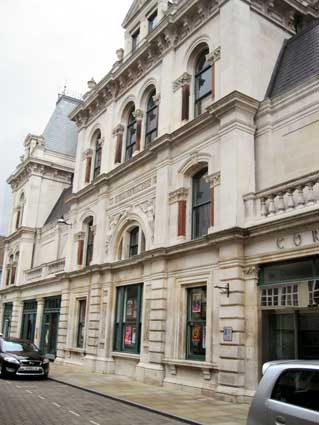
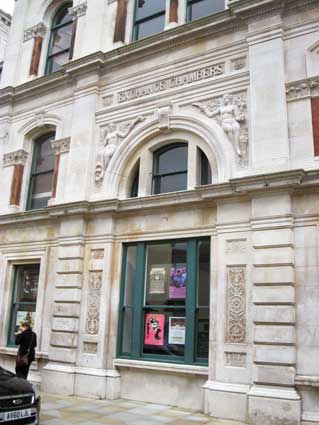 2012 images
2012 images
Directly opposite and to the left of the modern
entrance to the Corn
Exchange
and Film Theatre is the name 'EXCHANGE CHAMBERS' grandly
displayed
in relief serif'd
capital letters above
a semicircular classical arched window with figures of Ceres –
incidentally, an 18th Century statue of Ceres, once topping
the
Corn Exchange roof, is now displayed in weathered condition in the
foyer
of the Town Hall – and Pomona in the spandrels.
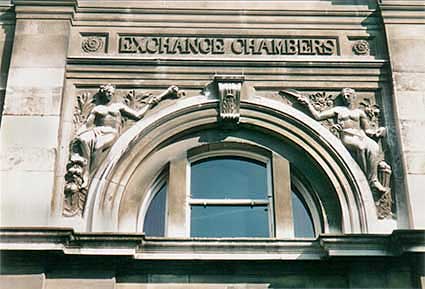 2004
2004
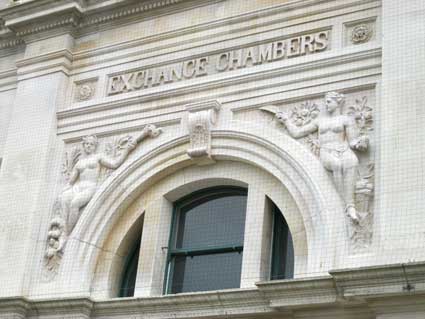 2012
Above left: the rather grimy state in June 2004. Above
right: here it is after extensive cleaning and renovation of
the exterior in 2012. The architect was Brightwen Binyon, whose name
crops up
on the Nethaniah almshouses on
Luther Road, and the builders were Grimwood & Sons of Sudbury. The
sculptor is uncredited. The building was opened
in 1882 and is Listed Grade II. We don't suppose many people notice it
these days.
It's
not even above the current main entrance to the Grand Hall and Film
Theatre.
2012
Above left: the rather grimy state in June 2004. Above
right: here it is after extensive cleaning and renovation of
the exterior in 2012. The architect was Brightwen Binyon, whose name
crops up
on the Nethaniah almshouses on
Luther Road, and the builders were Grimwood & Sons of Sudbury. The
sculptor is uncredited. The building was opened
in 1882 and is Listed Grade II. We don't suppose many people notice it
these days.
It's
not even above the current main entrance to the Grand Hall and Film
Theatre.
Below: an unusual view of the Exchange Chambers lettering and reliefs
from the rooftop of Mutual House, the
chimneypots of The Swan in the foreground.
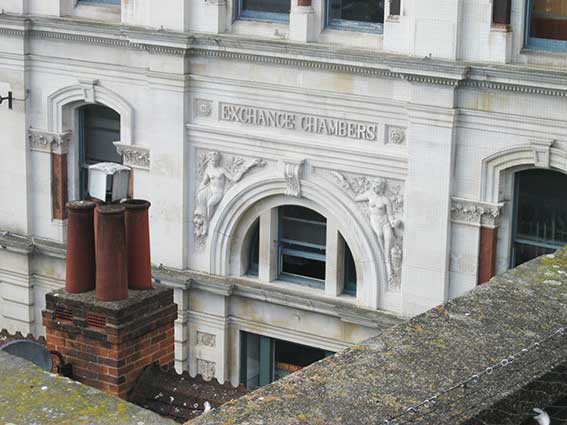 2018
image
2018
image
The Public sculpture of Norfolk & Suffolk (see Links) tells
us:
"Two decorative stone panels frame the semi-circular window with Ceres
to left with torch and cornucopia and Pomona with pruning knife and
apples to right. The door, to separate offices, is to the left of the
main entrance. Ceres was the Roman goddess of crops and Pomona of
fruit. Both reflect the building’s twin functions as a corn exchange
and fruit and vegetable market, transferred here from Falcon Street in
August 1888.
In Mediaeval times the Cornhill became the centre of trade and local
government in Ipswich. In 1810 the first Corn Exchange was erected by
the Corporation at a cost of £33,000. During the 1860s it was becoming
crowded on market days and the Council began to consider various
alternatives and in 1879 acquired the King Street site at the rear of
the Town Hall for £12,000. They agreed on the design (one of 15)
entered by Brightwen Binyon under the nom-de-plume "North Light". The
Corn Exchange was remodeled as a centre for meetings and entertainment
in the 1970s, re-opening in 1975."
The fruit and
vegetable market remained until 1970 and the last Corn Market was held
here on 29 June 1972.
Within The Great Hall
Meanwhile, inside the Corn Exchange at the top of the stairs into the
Great Hall, we find this half-round relief which echoes the 'Exchange
Chambers' feature above:
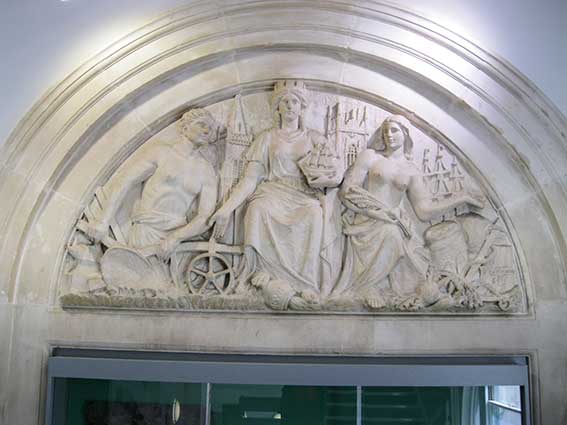
The central figure (of Britannia?) holds a ship
in full sail, has a
castle for a crown and her right foot rests on an upturned urn carved
with the name 'ORWELL' from which the waters of the river
flow. She is flanked by a male representing agricultural work and a
female (Ceres) representing the harvest. In the background the towers
of St Mary-le-Tower Church and St Lawrence
Church (you can see the intials 'S' and 'L'), also the masts and
rigging of a ship.
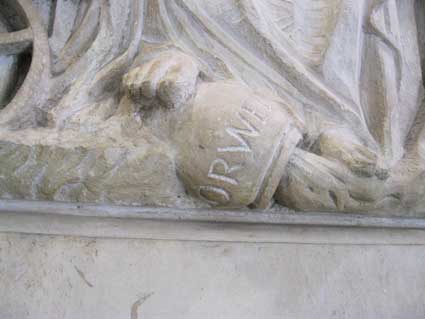
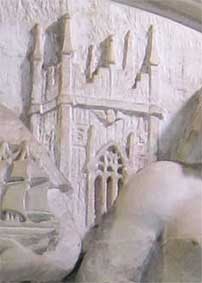
In the glass-fronted cabinet below this relief sculpture is a chunkily
baroque carving of the Borough crest in wood with gold highlights:
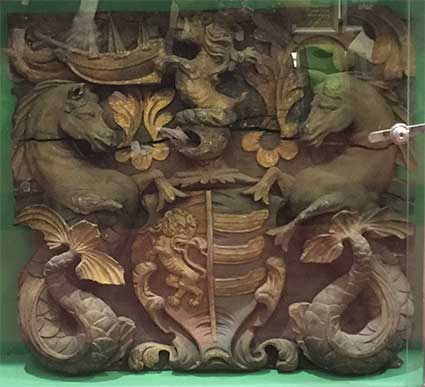 2017 image
2017 image
See our page on the Borough Coat of Arms for
further examples.
Delving even deeper into the main hall, many people miss the monograms
in the gold-painted, pierced spandrels:
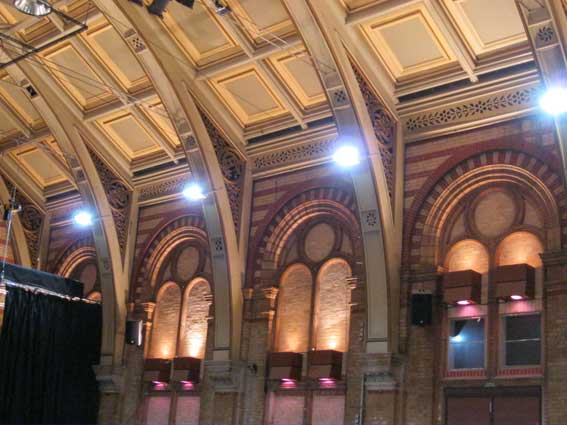
'ICE'
[Ipswich Corn Exchange']
'1882' [dated of the Great Hall's opening]
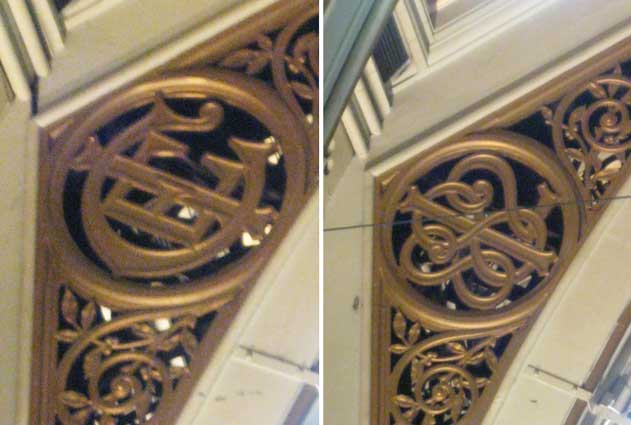
[UPDATE 20.1.2025: it was only
in late 2024, while attending a concert in the balcony seats in the
Corn Exchange, that we noticed the date monogram and its casting mark.
 2024
images by Mandy Gaylard
2024
images by Mandy Gaylard
’1882’
Casting mark below:
‘WALTER MACFARLANE & CO GLASGOW’
Also part of the Borough coat of arms at the
apex of the roof supports inside the Corn
Exchange,
pierced metalwork scrolls with olives and leaves surround the central
circle featuring a version of the lion rampant holding a sailing vessel
from the Borough coat of arms. The extended tongue, flaming mane and
whiplash tail all contribute to a dynamic – and rarely noticed – motif.
One can only imagine the painter on top of a scaffolding tower putting
the finishing touches to this gilded wonder.


Below: the Corn Exchange in 1934 – a sea of trilby hats.
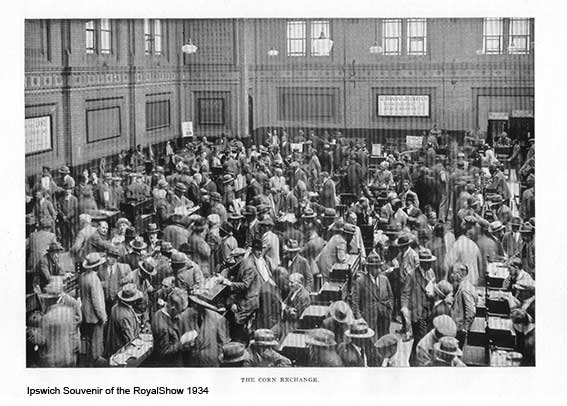
See also our Lettered castings
index page.
See also our King Street page for
historical maps of this vicinity.
See our
Cornhill
1
page for more on this
area.
Other related pages:
Westgate Street
Tavern Street
King Street/Lion Street/Arcade
Street
Princes Street
Giles sculpture
Home
Please email any comments and contributions by clicking here.
Search Ipswich
Historic Lettering
©2004 Copyright
throughout the Ipswich
Historic Lettering site: Borin Van Loon
No reproduction of text or images without express written permission
 2013
image
2013
image 1921 image
1921 image
 2004 images
2004 images

 2004 image
2004 image 2012
image
2012
image 2004 image
2004 image 2012 image
2012 image  2013
image
2013
image
 2012 images
2012 images
 2004
2004
 2012
2012 2018
image
2018
image


 2017 image
2017 image
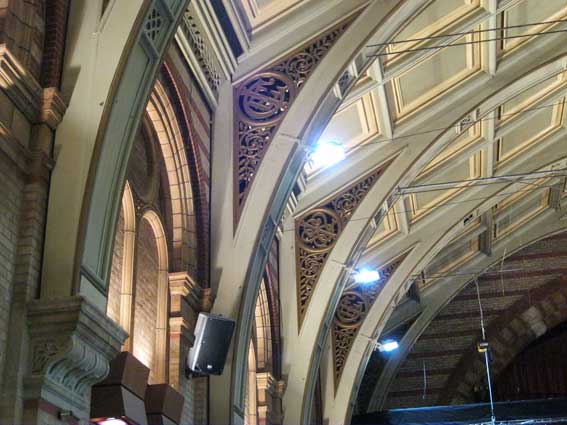

 2024
images by Mandy Gaylard
2024
images by Mandy Gaylard

